You know an indie game has made it big when other indie developers start making fangames based on it and the Touhou series has a ton of fangames. I’ve played my fair share of Touhou fangames over the years and at the end of the day Touhou – Wandering Souls remains not only my favorite Touhou fangame, but one of my favorite freeware indie games. This sidescrolling action RPG perfectly translates the gameplay of a bullet hell shmup series into an entirely different genre alongside some surprisingly deep mechanics and an outright obscene amount of content all while being made in the utterly unlikely RPG Maker VX engine.
Like with most fangames, it helps to be at least somewhat familiar with the source material so I’ll start by going over the basics. The Touhou series takes place in the world of Gensokyo, which is basically feudal Japan with ghosts, monsters, magic, and other mystical elements mixed in. The official series mostly consists of vertically-oriented bullet hell shmups which have had a significant amount of influence on the subgenre over the years, though there are also several fighting games and the very first game belongs to the breakout genre. There have been dozens upon dozens of fangames in every genre imaginable from platformers to visual novels, countless song remixes, and even an anime series so at this point the fact that Touhou – Wandering Souls is an action RPG platformer beat-em-up with bullet hell elements is par for the course. The plot of each game is straightforward and usually involves the series protagonist, a shrine maiden named Reimu, setting out to discover the source of a mysterious incident, such as the moon being stolen or winter not coming to an end, at which point she and several other magical girls shoot thousands of bullets at each other until the villain is discovered, defeated, and likely befriended. Touhou – Wandering Souls doesn’t stray from this basic storytelling formula as players once again take on the role of Reimu to figure out who has created large barriers all around Gensokyo while meeting (and almost always fighting) plenty of other characters from the series along the way.

You start the game playing as Reimu, but one of the defining features of Touhou – Wandering Souls is the fact that you actually control a party of three characters. Not long after finishing the tutorial you are joined by two other frequently playable characters, a witch named Marisa and a time-stopping, knife-tossing maid named Sakuya who is so blatantly inspired by Jojo’s Bizarre Adventure that she even works for a vampire. Unlike in most Touhou games, you can freely swap between each of the three characters whenever you want, though there is a 15 second cooldown time if you swap in the middle of combat. If your current character is defeated you can swap over to either of the other two (assuming they are both still alive) and you are only kicked out of a level with all of your experience and items intact if all three are knocked out. Thankfully, characters don’t stay out of the fight for long as they will immediately recover with half their maximum health and mana upon transitioning to a new screen or after waiting for a grey bar under their portrait to slowly fill all the way up. Characters slowly regenerate health and mana while they’re alive and not being used, but swapping to another character after one gets knocked out gives you a few valuable frames of invincibility while manually swapping does not so there is some strategy involved in deciding between sticking with a character until they run out of health or swapping to the best character for the current situation to allow other characters to recover more. This all might sound rather generous, but getting hit by a single big attack is often enough to wipe out all or most of a character’s health and even small attacks can rapidly add up, especially if they inflict status ailments or stunlock you, so realistically it’s common to be down to one character holding on by a thread as you try to buy enough time for one of the other two to revive.
Regardless of which character you are using, you have three main types of abilities at your disposal. First, you have your standard attack combo which you can perform by pressing the attack button up to four times in a row. The third hit in the combo is always some sort of ranged attack and you can perform one of two alternate attacks after the third or fourth hit by pressing up or down and the attack button. It’s a rather simplistic combo system and its usefulness gradually diminishes as the game goes on, though many of the up and down attacks have status ailments attached to them and these basic attacks are still handy for dealing small amounts of chip damage between your more devastating abilities. Skills make up the second, and arguably the most important, type of tool available to you. You use skills by pressing two or three directional buttons and then the attack button and skills consume 100, 200, or 300 SP depending on their strength; SP regenerates at a fast rate so you never need to wait long between skill uses. Some skills have one or two elements tied to them which enemies may be weak against or resist and they make up the heart of the combat system as the majority of your damage will come from properly chaining together skill uses. Though each of the three main characters has seven skills, you are limited by your weapon selection as skills are attached to weapons and most weapons only grant access to three or four skills.

Four magic spells per character, one for each element, are the final main abilities at your disposal. Unlike skills, which are instantly activated, spells require a substantial cast time during which you can get interrupted if you get hit and spells rely upon mana, which regenerates very slowly. While each character has access to their four spells regardless of their equipment, you only get access to fire magic after finishing the first area and water, wind, and earth magic are each respectively unlocked after collected 20, 40, and 60 of the ‘wandering souls’ (more on those later) so magic doesn’t see much use until later on. On the positive side of magic, there are a few very useful support spells, such as a heal spell for Marisa, and, in addition to dealing massive amounts of damage, most offensive spells stay around for a while after they are cast so you are free to move around and use skills or even start charging up another spell while enemies are being hit by a spell.
Alongside their offensive capabilities, the playable characters have access to a few handy support skills to help them survive. They have plenty of mobility on top of precision thanks to being able to dash on the ground and in the air, the ability to slow their decent by gliding, and access to an aerial jump if they fall or dash off of a ledge. This high degree of mobility is necessary because the screen can quickly fill with bullets and you can never stay still for long in a fight. You also have access to an omni-directional shield for times when it’s simply not possible to dodge everything, though it can only protect you from so much damage before it shatters so it’s always better to dodge if you can. Lastly, you have a Hyper Mode meter which consists of five nodes. Enemies sometimes drop items which fill up a node, you need at least three nodes filled to activate Hyper Mode, and it doesn’t take long at all for the nodes to deplete. That said, Hyper Mode lives up to its name as it boosts your attack and movement speed, raises your attack power, changes all of your normal attacks into much more powerful alternate versions, and significantly speeds up all of your regeneration, allowing you to unleash a nonstop torrent of skills and spells upon your foes. Hyper Mode isn’t something that you’ll be able to use every single fight, but it can completely turn the tide in even the most seemingly hopeless of situations.
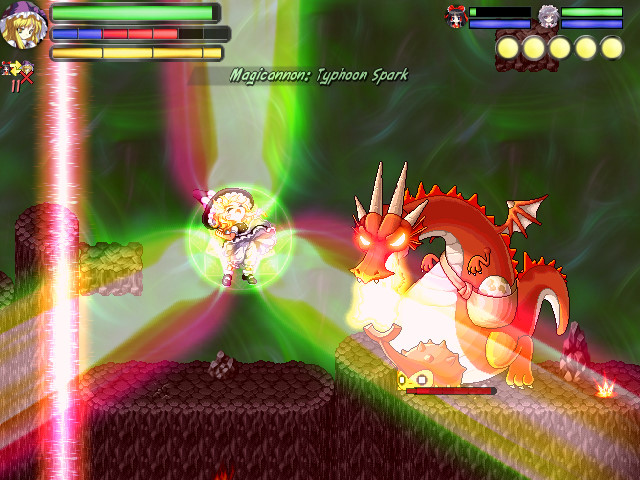
As far as the general gameplay goes, this is more of a beat-em-up than an RPG and more of an RPG than a platformer. To be clear, there are plenty of platforms to jump around on, but these primarily exist to create the shapes of the arena in which you fight enemies and less as a challenge in and of themselves; environmental hazards like falling rocks are rare and any challenging jumps in the game are almost exclusively for secret or alternate paths and almost never carry any penalty for failure. Levels are linear with a few secrets scattered along the way and your goal is ultimately simply to reach the end alive. However, your journey is frequently impeded by barriers so simply rushing past enemies is not an option. Blue barriers sometimes appear which can only be broken after every enemy in the room is defeated and leaving the room before accomplishing this task will make every enemy respawn, but it gives you a chance to heal up if your chances aren’t looking good. More commonly you will become trapped between two red barriers which form a makeshift arena. Enemies within these arenas usually appear in waves, with each new wave spawning in the moment you defeat every enemy in the previous wave, so it’s sometimes worthwhile to leave a single weak enemy alive for a while if you need time to recover. In addition to red and blue barriers you sometimes encounter thin barriers which are deactivated by finding a switch somewhere in the level and they remain deactivated for the entire rest of the game, even if you fail to complete the level on the attempt in which you deactivated them, which makes them serve as a sort of shortcut system in larger levels. The last type of obstacle you can encounter is a swirling portal. These portals are completely optional elements and they start with somewhere around three or four enemies around them which get replaced by new enemies immediately after they are killed rather than coming in set waves. Defeating every single enemy tied to a portal will make the portal explode and reward you with some cash and/or AP, which is like experience points for equipment. Inevitably, each level will end with either a red barrier arena fight to the death against some tough waves of enemies or a fight against a proper boss.
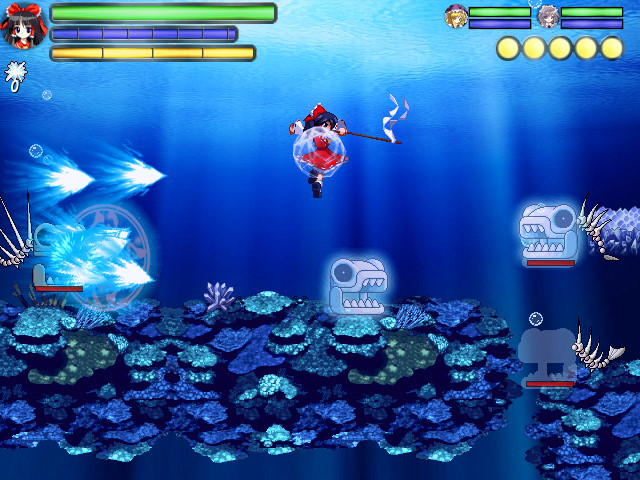
Bosses can be incredibly dangerous, but normal enemies are often just as challenging. While a single normal enemy is rarely a problem, you’re also never dealing with just one enemy other than at the very end of a fight. Groups of small enemies which lunge at you are mixed in right alongside enemies who specialize in homing bullets or spread shots. While a single hit from most attacks won’t hurt too much, getting hit once usually stuns you just long enough for other enemies to get their own attacks in and getting hit at point-blank range by every bullet in an attack before they’ve had time to spread out can take a character from full health to dead in the blink of an eye. Though each region has its own unique enemies with little in the way of overlap, there are recurring enemy types to watch out for, such as slimes which will multiply if not dealt with quickly and pixies which have a whole host of support capabilities ranging from inflicting the player with the slow status ailment to healing up other enemies or even giving them temporary invincibility.
Enemies tend to have one or two attacks which they stick to using periodically, but many enemies can also change things up by casting a unique spell. Like your own spells, these enemy spells have a cast time so you have a chance to kill an enemy before their spell goes or at least silence or interrupt it, but, also like your own spells, these abilities can be devastating if they go off. When an enemy spell is in play you can rarely do much beyond focusing on dodging it as these spells tend to consist of homing attacks or nonstop barrages of projectiles falling in from the sky. Tougher, miniboss-style enemies also often get thrown into the mix, especially later on when you might be confronted with two or three such enemies simultaneously. These tougher enemies are still a far cry away from being proper bosses, but they frequently have access to at least two different types of particularly nasty spells in addition to a variety of normal attacks which you’ll have to confront while still being wary of weaker enemies launching their own attacks. Invincible magical turrets are also frequently thrown into the mix during normal encounters and, like the enemies themselves, these turrets are general unique to each region with attacks such as scattering dozens of harmless bullets across the arena which all simultaneously because dangerous and rush towards your character or a giant laser beam which moves clockwise and counterclockwise; a few arenas are even dedicated entirely to simply surviving against a horde of turrets for a set amount of time. Even when a level doesn’t end in a true boss fight, the enemies you’ll encounter at the end and along the way will make your journey anything but easy.
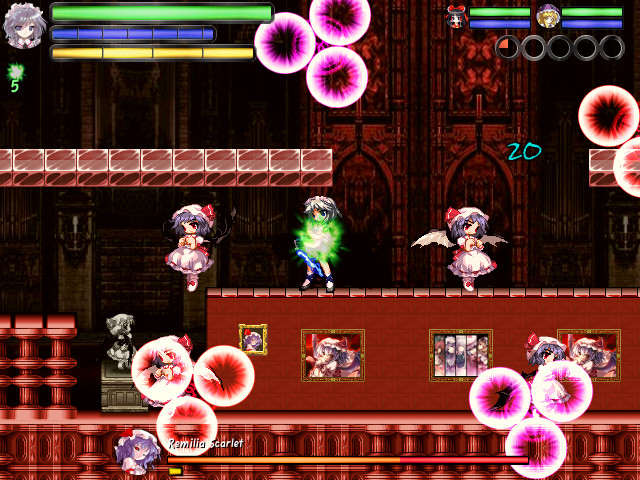
Even though fighting normal enemies is fun, the bosses are unsurprisingly the real stars of the show. All of the bosses come from the official games and Touhou – Wandering Souls does a great job of translating many of their abilities into the sidescrolling beat-em-up format. Most bosses like to move around a lot and they’re all about the same size as your own characters so you need to be particularly wary of when and where you use your skills in order to deal any significant amount of damage to them. The one time when you can always get in plenty of hits against a boss is when they are in the middle of casting a spell, though once the spell goes off you usually need to focus entirely on survival. Every boss has a host of spells on their disposal and, unlike normal enemies, bosses usually fly above the arena while these room-filling attacks go off, making it incredibly difficult to hit them with most skills, assuming you can even find time to attack in the first place.
Each boss has multiple health bars and these are more than just for show. On the beneficial side of things bosses will drop an item to restore your health, mana, or hyper meter every time you deplete a health bar so you can use magic and enter Hyper Mode more frequently than usual during these fights. In most cases, the real fight doesn’t begin until a boss loses about half of their health bars because it is at this point that many of the bosses will either start to use their most dangerous, signature spell and/or permanently enter a Hyper Mode of their own, becoming far more aggressive and leaving much less time between spell onslaughts. Bosses are even usually able to send out small, though far from insubstantial attacks while their spells are going on and many have more remote abilities which stick around on top of their other attacks, such as periodically summoning in small doll enemies or making tornadoes move back and forth along the platforms. You may have a three to one advantage against bosses, but the sheer intensity of their attacks combined with how frequently they can have two or more attacks going off at the same time means you have little time to relax during even the earliest of boss fights.
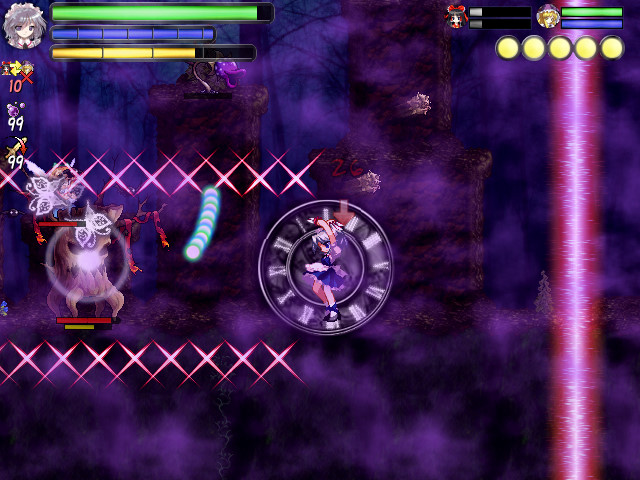
So, just what is a ‘wandering soul’ anyway? For the most part these souls are simply collectible plot MacGuffins, though they are more valuable than the average Mario star. The world is divided into seven regions plus an eighth region where you can fight waves upon waves of enemies from the first six regions and get rewarded with wandering souls based on how far you get. Each of the seven main regions is divided into about six levels and these levels are in turn divided into groups of one or two by barriers; completing every previous level in a region unlocks the next set of levels. Of these regions, the fourth through seventh regions all require you to have obtained a minimum number of wandering souls on top of having completed certain previous regions before you can enter them. You get a wandering soul the first time you clear each level and fully clearing the eighth region’s gauntlet grants you a total of six wandering souls, but with 100 souls to find and a minimum requirement of 60 just to enter the final region this is clearly not the only source of souls. Some levels have one or two ‘hidden souls’ within them which are usually tucked away within secret side rooms where you will need to either fight through some particularly tough waves of enemies or complete a task such as making it through an obstacle course within a time limit without taking a certain amount of damage. Other souls are rewarded for completing a level while fulfilling certain requirements, such as not letting any characters die, not using spells, or reaching the end within a time limit. You keep any hidden souls you find even if you fail to finish the level and all souls are clearly marked in the level select hubs so you always know exactly how many souls are in each level. In addition to being required for unlocking new regions and for gaining access to new spells, wandering souls are also useful for equipment purposes as the shop will gain new items when you hit various hidden soul milestones. As a general rule of thumb, if a level seems too hard you might want to consider hunting down any souls you passed up along the way because the spells and equipment they unlock can make a huge difference.
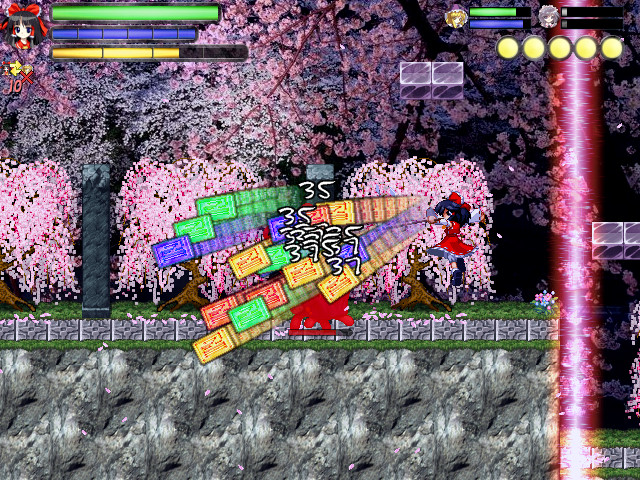
Customization is a crucial part of Touhou – Wandering Souls and this is where the RPG elements really kick in. Every character has an equipment slot for their specific weapon type as well as four elemental slots for shared accessories and what gear you choose to give each character has a massive impact upon how that character plays. Weapons are certainly the most important pieces of equipment because your skills are tied to them, but skill access isn’t the only thing to consider. The weapons themselves have all sorts of stats tied to them such as increases mana or SP regeneration, faster revival times, extra damage with a certain type of element, and so on. You might prefer the skills offered by one weapon, but if you like using your normal attacks frequently it could be worthwhile to use another weapon with the ‘Super Combo’ passive which turns your normal attacks into their Hyper Mode versions at all times. Accessories can make almost as much of a difference as the weapons themselves, especially when it comes to later accessories which can fit into two or even all four of the slots instead of only a specific slot. For example, many of Sakuya’s abilities stop time while they’re going off, but the SP gauge continues so regenerate so she’s particularly great for skill spamming and I like to combine her 200 SP Deadly Kunais attack, which sends homing daggers at enemies and poisons them, with her 100 SP Hell Corridor attack, which creates two long rows on knives in front of her and crushes them together. In order to get the most out of these abilities, I make sure to always equip a weapon with access to both of them, but in particular I used the Silver Knives with 30% SP regeneration for much of the game alongside the Great Warrior Headband with its 50% SP regeneration boost and other accessories which boosted fire damage (Hell Corridor is fire elemental) to turn an already great skill combination into one capable of taking off multiple health bars from bosses before they even got a chance to move. On the other hand, Marisa has some of the strongest spells in the game, but you don’t have access to most of them early on and most of her skills have high attack power at the cost of being either close range or requiring her to remain stationary while using them so I focused on giving her accessories which boosted her chances of surviving early on and then gradually shifted to ones which benefited her spells. As for Reimu, she’s the most balanced of the three characters so I usually gave her all sorts of accessories which made her immune to the various horrible status ailments or which increases her resurrection speed. Whether you want to take full advantage of a specific skill or want to reduce a character’s weaknesses, equipment really does make all the difference.
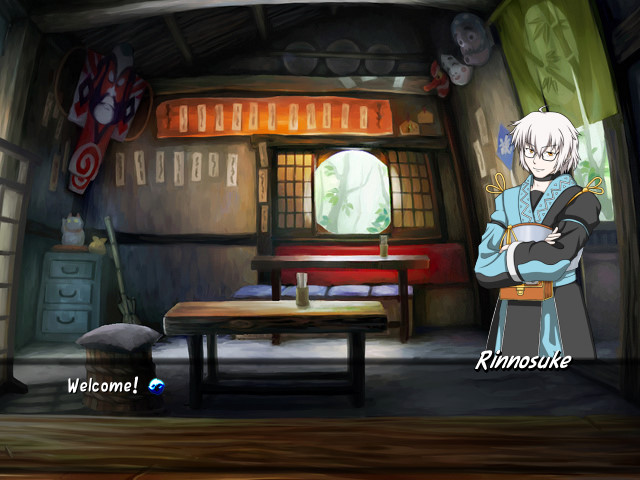
The one part of the equipment system which can be controversial is the leveling aspect. Your characters all gain experience points with the current active character gaining slightly more than the other two and, though they balance out by the end, Reimu gains SP faster, Marisa gains mana faster, and Sakuya gets more health. However, every single piece of equipment, every skill, and every spell also levels up. Skills and spells all start at level zero and gradually gain levels the more you use them up to a maximum of level ten. In this way your favorite abilities grow with you and aren’t 100% reliant upon your stats. The one downside to this system is the exact nature of this growth is never made clear. The game never tells you that skills and spells level up through use, there is no indication of how close you are to leveling up an ability, and you can’t even see how much of a difference each of these levels actually makes unless you constantly pay attention to your damage numbers. The more controversial side of things is tied to equipment levels. Equipment gains AP which, just like the experience points your characters gain, is obtained from killing enemies and sometimes from treasure chests and the active character gains slightly more AP than the other two. Each piece of equipment starts at level zero and can reach a maximum level of five. On the one hand, this is a way for your favorite gear to grow alongside you just like your skills and spells, granting you one more way in which you periodically become stronger and an old maxed out weapon is often stronger than a new level zero weapon so only the really early items ever become completely obsolete. However, this system also leads to encouraging players to repeatedly grind through old levels if the newest levels are proving too tough because every upgrade is only in truth an eventual upgrade which starts off as about on par with or likely even outright worse than whatever item you’re replacing. This is a particularly nasty problem when it comes to weapons because the skills on weapons are also tied to their level with only one or two skills being available at level zero and the final skill usually unlocking at level three or four. In other words, changing to a new weapon is a massive commitment because it means not only a reduction in raw power compared to your previous weapon, but it also means that you’ll have to do a whole lot of grinding to even start using all the skills you want from it unless everything you want is at level zero. Whenever the shop gets new supplies it always has new weapons for all three characters, but the way weapons level means trying to give new gear to more than one character at a time is basically a death sentence and the system ends up feeling counterproductive.
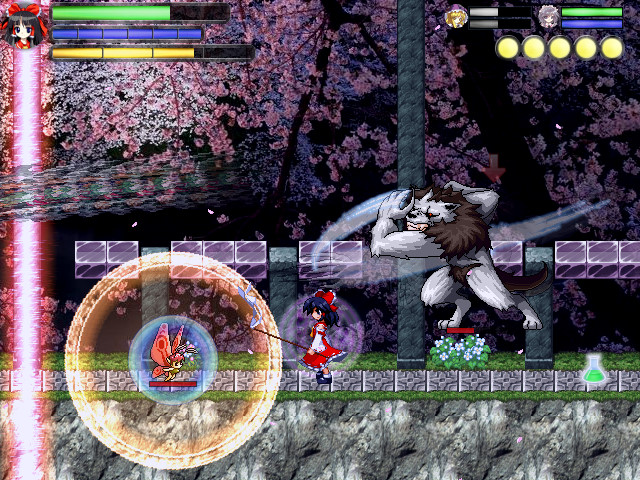
Aesthetically, this game is the sort of carefully crafted collage almost entirely exclusive to freeware fangames and this is an aspect which people will either love or hate. With the possible exception of one or two minor details, absolutely none of the aesthetics here are unique. The character and boss sprites are from the Touhou fighting games, the music is from the fighting games and the shmups, many environmental details are default RPG Maker sprites, and almost every normal enemy is taken straight from MapleStory of all things and there are even a few other games listed as sprite sources in the credits. These are wildly different sources which share little to nothing when it comes to their genres, some are in overhead views while others are in sidescrolling views, and their original creators have nothing to do with each other and by all accounts they shouldn’t work together at all, yet they do and I love it. The difference between this and a lazier game is that every element has been picked out with care and utilized even more carefully. Even though they aren’t similar on the surface, all of the sources do in fact have a few core elements in common, such as that they are all 2D and they all are cartoonish rather than realistic with fairly close color palettes; if two elements don’t work well together, they simply don’t appear near each other. Likewise, MapleStory sprites with their limited animations work just fine for normal enemies, but they wouldn’t be a good fit for more elaborate boss fights, so the more detailed Touhou characters are distinctly separated from them. RPG Maker elements for that matter would stand out a bit too much if they were used excessively, so they are primarily used for platforms and for small details like rocks and trees. It takes a lot of skill and effort to make a game with entirely original assets, but knowing how to combine existing assets from multiple sources into a single, congruent aesthetic is a skill all on its own and one which I always appreciate when it’s utilized as well as it is here.
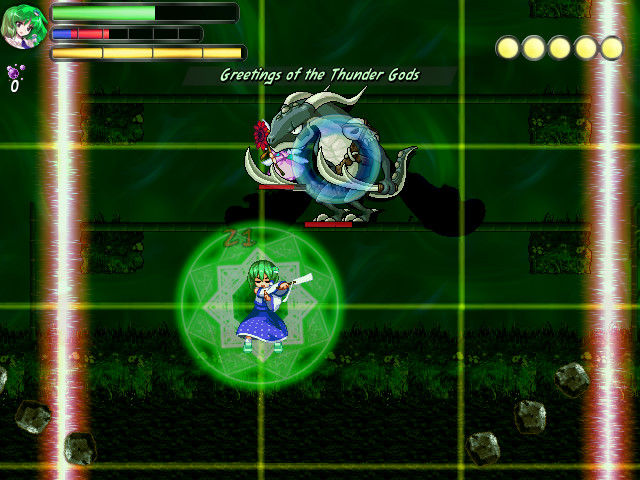
Difficulty in Touhou – Wandering Souls is a particularly interesting thing. You have three difficulty levels to choose from when you start the game, but other than enemies hitting for far more damage and the addition of a few more turrets and possibly a few more enemies I didn’t notice any significant changes between the three and the highest difficulty setting, Lunatic, makes blocking almost worthless so you’re not missing out on much if you play on a lower setting. However, defeating the final boss and watching the credits roll is far from the end of the game and is, in fact, in many ways where the game truly begins. Clearing the final level unlocks Chaos Mode and, with it, 100 more wandering souls to find. Calling this post-game content or New Game+ is honestly selling it short because there is just so much to it. You’re not actually starting a new game, you still have all your equipment, all your levels, and access to every area in the game, but every level gains a Chaos Mode version of itself. The layout of a level in Chaos Mode remains the same, but the platforming isn’t the focus to begin with and the combat is what matters. On top of every enemy being balanced with endgame levels and equipment in mind, the fights in Chaos Mode levels are entirely different, far more dangerous versions of their original counterparts and there are even a few entirely new enemy types thrown into the mix. Bosses in particular are more dangerous in Chaos Mode because, while they don’t get any new attacks, their attacks are faster and they are so aggressive that they’ll often start one attack long before their previous attack has left the screen. New equipment still periodically appears in the shop and a few pieces of unique equipment can also be dropped by Chaos Mode enemies and all of it is incredibly strong with game-changing capabilities such as outright eliminating cast times. If this wasn’t enough, each region has an entirely new, extraordinarily difficult level to unlock within it and there are even a few new boss fights thrown in for good measure. To top it all off, you can recruit many of the bosses as playable party members. You can still only have three characters in your party at a time and these boss characters are a bit more simplistic than the main trio as they each have a single weapon with three or four skills and not necessarily a full complement of four spells, but they are otherwise strong and entirely viable alternative characters. The initial journey through the game is entirely enjoyable on its own, yet in many ways it feels like it exists primarily as a way of preparing you for Chaos Mode with its unforgiving fights, its cornucopia of unlockables, and the virtually unlimited freedom it gives you when it comes to picking the order in which to tackle its levels.
It’s at last time to bring this rather lengthy article to a close and there’s not much left to say. Touhou – Wandering Souls has its flaws, yet it is an incredibly ambitious game, and not just be fangame standards, and so much of what it sets out to do really does work incredibly well. This is a game which blends together an utterly bizarre array of genres, yet it manages to provide somewhere around an astonishing 30 hours of content for this strange formula and it does so all while maintaining a perpetually high degree of entertainment.